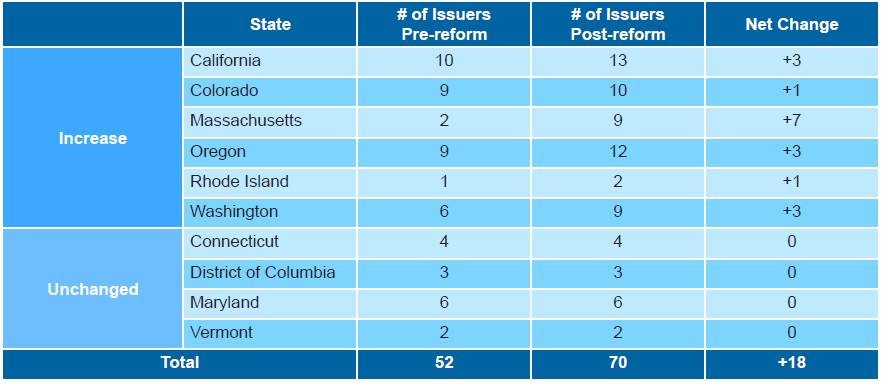Consumers in State Insurance Exchanges Will Have More Options Than Are Currently Offered in Those States
June 17, 2013 - Robert Wood Johnson Foundation
Princeton, N.J.—The number of insurers that offer nongroup plans to
consumers this fall in state-run health insurance exchanges will be much greater
than the current number, according to an analysis from the Robert Wood Johnson
Foundation (RWJF).
RWJFfs State Health Reform Assistance Network compared insurers offering
plans prior to national health reform with insurers applying to operate in state
exchanges. The analysis uses data from all 10 states that have released
information on carriers that will operate in their insurance marketplaces.
Across the 10 states, the number of carriers offering nongroup insurance
plans will increase substantially, from 52 to 70 plans—an increase of 35
percent. Six of the 10 states will see more insurers operating on the nongroup
exchange compared to the number of significant competitors pre-reform. Four
states expect no change.

gMore carriers competing in a state means more choice for consumers. That
increases pressure on insurers to reduce price and improve service,h said Andy
Hyman, who leads health coverage programs at the Robert Wood Johnson Foundation.
gThis level of competition signals that the state exchanges will be vibrant
marketplaces.h
Researchers focused on the nongroup market because it currently offers
limited options and little information to guide consumer choice, and will
therefore be substantially altered by the Affordable Care Act. They say that
because tax credits for individual coverage premiums require obtaining insurance
through an exchange, most insurance companies committed to the nongroup market
will choose to participate.
Massachusetts is the only state for which the researchers have an indication
of the long-term impact of reform on competition. In the seven years since the
state implemented health reform, they say the number of competitors more than
quadrupled and market share is now far more evenly distributed as well. The
analysis says that in the year before reform (2005), Blue Cross Blue Shield of
Massachusetts (BCBSM) dominated the nongroup market with an 80 percent market
share. In 2013 it has less than 40 percent of nongroup enrollment. With
re-structuring of the statefs exchange to comply with the ACA for 2014, five
carriers are expected to have nearly as much, or more, nongroup enrollment as
BCBSM.
gHow competition will develop in the states is still evolving, but early
evidence is showing an increase in competition in most state-based exchanges,h
said Heather Howard, director of RWJFfs State Health Reform Assistance Network
and a lecturer in public affairs at Princeton University. gThe robust
competition wefll see in these states is good news for consumers, because
companies have an incentive to provide high-quality, affordable plans through
the state-based exchanges, and carriers are clearly interested in these new
markets.h
The 10 states analyzed for the report are California, Colorado, Connecticut,
District of Columbia, Maryland, Massachusetts, Oregon, Rhode Island, Vermont and
Washington.
About the Robert Wood Johnson Foundation
The Robert Wood Johnson Foundation focuses on the pressing health and health
care issues facing our country. As the nationfs largest philanthropy devoted
exclusively to health and health care, the Foundation works with a diverse group
of organizations and individuals to identify solutions and achieve
comprehensive, measurable, and timely change. For more than 40 years the
Foundation has brought experience, commitment, and a rigorous, balanced approach
to the problems that affect the health and health care of those it serves. When
it comes to helping Americans lead healthier lives and get the care they need,
the Foundation expects to make a difference in your lifetime. Follow the
Foundation on Twitter at www.rwjf.org/twitter
or Facebook at www.rwjf.org/facebook.